Concerned about being onboard when a cruise ship emergency evacuation plan takes place? Even while this is rare, it is a requirement for passengers to be well-prepared and aware of safety protocols. Discover the plans and devices that you need to know about.
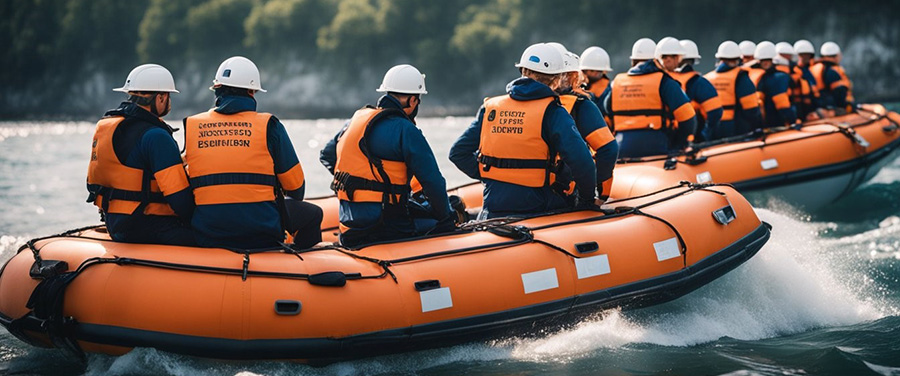
For a Cruise Ship evacuation situation, the key is to stay calm and follow crew instructions promptly. Knowing the ship’s layout, safety points, and procedures can make a significant difference in ensuring your safety during such events.
When boarding a cruise, you might not immediately think about potential emergencies, but it’s good to have a basic plan. Familiarizing yourself with lifeboat locations and muster stations can provide peace of mind. Cruise ships are equipped with multiple safety measures, and understanding these can enhance your confidence in handling any incidents.
Safety on cruise ships often exceeds that of other types of travel due to rigorous standards and procedures. By taking a moment to review the cruise ship emergency protocols. You contribute to not only your well-being but also support the efficient management of onboard safety processes.
Understanding Cruise Ship Safety
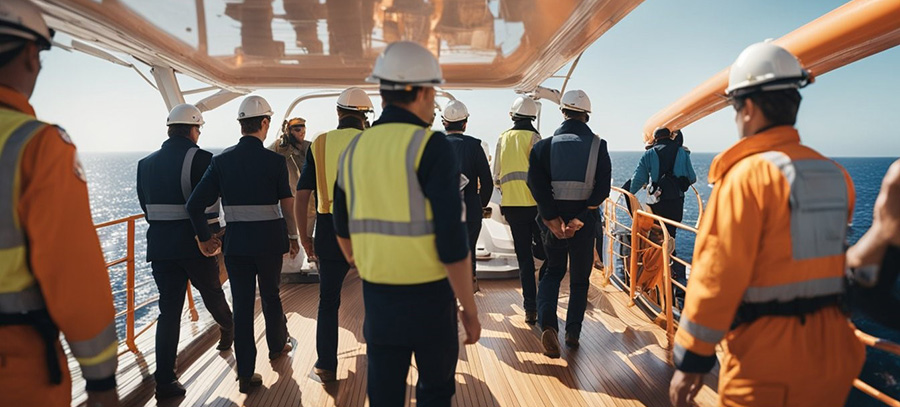
When you set sail on a cruise ship, safety is a top priority. Cruise Lines aim to prevent emergencies and ensure your well-being. Key areas include the ship’s design, advanced navigational tools, and comprehensive safety protocols.
Design and Stability
Cruise ships are engineered with stability in mind to handle rough seas and various weather conditions. Stabilizers are crucial as they help minimize motion, ensuring a smoother journey.
The hull is designed to withstand the elements, distributing weight evenly. Watertight compartments are integrated to maintain buoyancy even if one part is breached. This ensures that a ship can remain afloat in adverse conditions.
Lifesaving equipment is abundant, including lifeboats and lifejackets, strategically placed for easy access. Designs also include emergency exits in case of a cruise ship evacuation. It is required that the doors and exits are made of fire-resistant materials. These features enhance overall safety, making cruise ships a dependable mode of travel.
Navigational Safeguards
Cruise ships are equipped with advanced navigational systems to avoid potential hazards. Radar systems and GPS are pivotal as they enable precise tracking and route adjustments. These tools work together to ensure ships steer clear of obstacles.
The bridge, where navigation occurs, is staffed with skilled officers operating sonar and autopilot technologies. These technologies collaborate to prevent accidents, such as collisions or running aground.
Ships often traverse international waters, necessitating adherence to stringent maritime regulations and safety checks. Weather monitoring systems allow crew to avoid treacherous zones, ensuring passenger and crew safety by redirecting when necessary.
Safety Protocols and Drills
Cruise lines conduct regular safety drills to prepare you and your fellow passengers for potential emergencies. These drills cover cruise ship emergency evacuation procedures, lifejacket use, and lifeboat boarding processes.
Crew members receive extensive training in crisis management, first aid, and firefighting. Onboard safety briefings ensure you’re familiar with emergency routes and assembly stations.
Communication systems are robust, offering announcements in multiple languages to reach all passengers. By prioritizing safety training, cruise ships aim to mitigate the impact of unexpected events, helping you feel secure throughout your journey.
Emergency Scenarios and Procedures
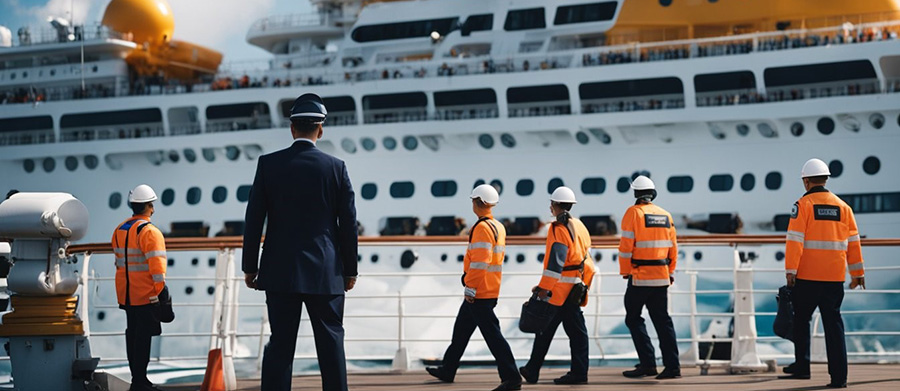
On cruise ships, being prepared for various emergencies is essential to ensure the safety of all passengers and crew. Awareness and understanding of procedures play a vital role during incidents such as fires, man overboard situations, severe weather, and medical emergencies.
Cruise ship emergency evacuation scenarios and procedures are also included. It is highly recommended to familiarize yourself with this information, especially on your first time voyage.
Fire Onboard
A fire onboard is a critical situation requiring quick action. Familiarize yourself with the locations of fire extinguishers, alarms, and escape routes. Participate actively in muster drills, as they will guide you on how to respond during an actual fire.
Crew members are trained to handle fires with specialized equipment. If you detect smoke or fire, sound the alarm immediately and follow crew instructions. It’s crucial to proceed calmly to your muster station without using elevators.
Man Overboard
Man overboard situations demand prompt reporting and response. Alert the nearest crew member or use available communication devices to report the incident. Stay observant and point towards the individual in the water to maintain their visibility.
Crew members deploy life rings and initiate rescue operations swiftly. It is essential not to attempt a rescue yourself, as this could lead to further emergencies. Follow announcements for instructions regarding further plans and safety procedures.
These procedures could be handy for cruise ship emergency evacuation situations. There could be a situation where you would need to jump ship. Understanding the man overboard policies could help. You can read more about What Happens if You Fell Off a Cruise Ship.
Severe Weather and Natural Disasters
Cruise ships are often equipped to handle severe weather. When adverse conditions are anticipated, you may receive notifications instructing you to stay indoors or relocate to a safer area of the ship.
In cases of significant weather changes, such as hurricanes, the ship may change course to avoid danger. Familiarize yourself with instructions in these situations, as they may involve adjusting plans or procedures, especially in extreme weather conditions.
Medical Emergencies
For medical emergencies, cruise ships are staffed with medical personnel and facilities capable of handling various health issues. In case of illness or injury, report immediately to a crew member or the medical center. Consistent communication is key to ensuring a swift and effective response.
The crew can assist with everything from minor discomforts to urgent care needs. When a critical situation arises, you may be advised to prepare for evacuation or patient transfer to onshore facilities for advanced treatment. Pay attention to all guidance provided by medical and crew staff.
Evacuation Protocols
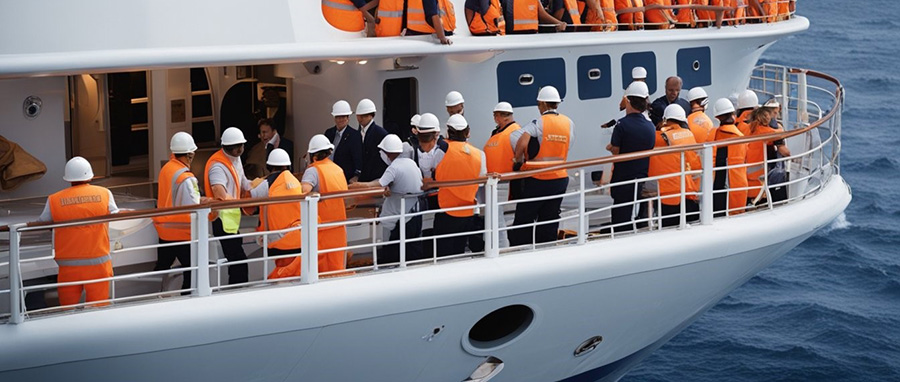
When you’re on a cruise ship, safety takes top priority. Understanding cruise ship emergency evacuation protocols, can ensure you and your fellow passengers remain secure when unexpected situations arise.
Lifeboats and Liferafts
In case of an emergency, knowing about lifeboats and liferafts can make a big difference. Lifeboats are typically larger and motorized, providing essential supplies for survival at sea. Cruise ships are equipped with enough lifeboats to accommodate all passengers.
Liferafts, on the other hand, are inflatable and serve as supplementary evacuation units. They are designed for easy deployment and are often located in accessible areas along the ship’s sides. Familiarize yourself with their locations and operation instructions detailed in the ship’s safety video or safety briefing.
Assembly Stations
Assembly stations are strategically placed areas where passengers gather during an emergency. Each passenger is assigned a specific assembly station as designated on their boarding pass or key card. It is crucial to remember your assembly station’s location; maps and signage throughout the vessel can assist with this.
Once at the station, crew members will guide you on further procedures. Attending the muster drill during the beginning of your cruise is vital, as it acclimates you to evacuation protocols and your assembly station’s location.
Mustering and Headcounts
During an emergency, mustering at your assigned station is a critical step. Here, crew members ensure that everyone is present and accounted for through systematic headcounts. This process is necessary to confirm the total number of passengers before moving to evacuation.
Any discrepancies or missing persons are promptly addressed to ensure everyone’s safety. Pay close attention to safety announcements and crew instructions, as your cooperation plays a significant role in the smooth execution of evacuation procedures.
After Emergency Support
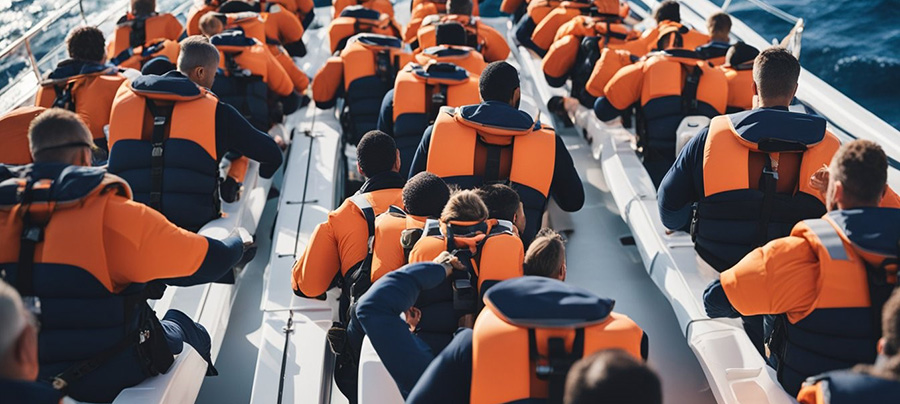
After a cruise ship emergency evacuation, there are essential steps in place to assist passengers. Key actions include reuniting families, providing mental health support, and conducting thorough investigations.
Passenger Reunification
After an evacuation, your priority will be reuniting with your family and loved ones. Cruise lines have teams ready to help you connect with family members who might have been on board. They often provide designated areas where family members can gather and seek assistance.
Communication Tools:
- Information Desks: Available at designated centers.
- Family Notification Systems: Track and notify family members about your whereabouts.
Support Staff: Trained personnel assist in compiling passenger lists and locating individuals quickly. You’re encouraged to stay in designated areas to expedite this process, ensuring everyone is accounted for promptly.
Trauma and Counseling Services
After a cruise ship emergency evacuation, emotional well-being is crucial. You might experience shock or emotional distress, so cruise lines often have counseling services available. These services are typically provided by professional counselors trained in dealing with post-trauma situations.
Counseling Options:
- Individual Sessions: One-on-one counseling for personalized support.
- Group Sessions: Share experiences with others in a supportive environment.
Counselors are there to help you process emotions and begin recovery. It’s important to use these services freely to address any trauma you might be experiencing and to guide you on the path toward emotional healing.
Investigations and Reports
Post-cruise ship emergency evacuation, detailed investigations occur to understand what happened. Cruise lines, alongside maritime authorities, will commence thorough examinations. You might be asked for your account of the events, which can provide valuable insights.
Data Collection:
- Passenger Interviews: Your account can contribute important details.
- Evidence Gathering: Collecting physical evidence and reviewing logs.
Results from these investigations help improve safety protocols and prevent future incidents. These reports can also inform policy changes and enhance training for crew members, making future cruises safer for you and others.
Conclusion – Not to Worry
Today’s Cruise ships are among the safest ways to travel, giving you peace of mind. Cruise ship emergency evacuations are very rare, so you can relax. Cruise lines follow strict international safety standards to make sure your journey is secure.
Additionally, the crew is trained extensively, practicing drills and safety checks regularly. Therefore, they are prepared to handle any unlikely scenario. Modern ships also come equipped with advanced safety technology, adding extra layers of protection.
In the rare event of an emergency, you’ll receive clear guidance every step of the way. So, go ahead and pack your bags with confidence! Rest assured that cruises are designed not only for adventure but also for safety. Enjoy the ocean, relax, and let the crew handle the rest—your dream vacation is waiting.
